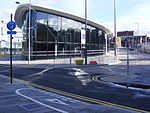Rochdale Town Hall is a Victorian-era municipal building in Rochdale, Greater Manchester, England. It is "widely recognised as being one of the finest municipal buildings in the country", and is recorded in the National Heritage List for England as a designated Grade I listed building.
The Town Hall functions as the ceremonial headquarters of Rochdale Metropolitan Borough Council and houses local government departments, including the borough's civil registration office.
Built in the Gothic Revival style at a cost of £160,000 (£15.9 million in 2024), it was inaugurated for the governance of the Municipal Borough of Rochdale on 27 September 1871.
The architect, William Henry Crossland, was the winner of a competition held in 1864 to design a new Town Hall. It had a 240-foot (73 m) clock tower topped by a wooden spire with a gilded statue of Saint George and the Dragon, both of which were destroyed by fire on 10 April 1883, leaving the building without a spire for four years.
A new 190-foot (58 m) stone clock tower and spire in the style of Manchester Town Hall was designed by Alfred Waterhouse, and erected in 1887.
Architectural historian Nikolaus Pevsner described the building as possessing a "rare picturesque beauty". Its stained-glass windows are credited as "the finest modern examples of their kind".The building came to the attention of Adolf Hitler, who was said to have admired it so much that he wished to ship the building, brick-by-brick, to Nazi Germany had the United Kingdom been defeated in the Second World War.










